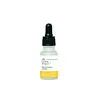What's inside
What's inside
 Key Ingredients
Key Ingredients

 Benefits
Benefits

 Concerns
Concerns

 Ingredients Side-by-side
Ingredients Side-by-side

Water
Skin ConditioningNiacinamide
SmoothingGlycerin
HumectantXylitylglucoside
HumectantAnhydroxylitol
HumectantXylitol
HumectantPhenoxyethanol
PreservativeEthylhexylglycerin
Skin ConditioningXanthan Gum
EmulsifyingCyamopsis Tetragonoloba Gum
Emulsion StabilisingAlpha-Arbutin
AntioxidantEDTA
Brassica Campestris Seed Oil
Skin ConditioningGlycyrrhiza Glabra Root Extract
BleachingPolyglyceryl-3 Diisostearate
EmulsifyingAlthaea Officinalis Root Extract
Skin ConditioningOryza Sativa Bran Extract
Skin ConditioningPalmaria Palmata Extract
Skin ProtectingBellis Perennis Flower Extract
Skin ConditioningWater, Niacinamide, Glycerin, Xylitylglucoside, Anhydroxylitol, Xylitol, Phenoxyethanol, Ethylhexylglycerin, Xanthan Gum, Cyamopsis Tetragonoloba Gum, Alpha-Arbutin, EDTA, Brassica Campestris Seed Oil, Glycyrrhiza Glabra Root Extract, Polyglyceryl-3 Diisostearate, Althaea Officinalis Root Extract, Oryza Sativa Bran Extract, Palmaria Palmata Extract, Bellis Perennis Flower Extract
Water
Skin ConditioningNiacinamide 10%
SmoothingOryza Sativa Extract
AbsorbentIsodecyl Neopentanoate
EmollientSqualane 5%
EmollientSorbitol
HumectantPentylene Glycol
Skin ConditioningHydrogenated Polyisobutene
EmollientRice Ferment Filtrate
Skin ConditioningButylene Glycol
HumectantRosa Damascena Flower Water
MaskingCaffeine 1%
Skin ConditioningGlycyrrhiza Glabra Root Extract
BleachingGlycerin
HumectantAcrylates Copolymer
Vp/Polycarbamyl Polyglycol Ester
Hydrolyzed Sesame Protein Pg-Propyl Methylsilanediol
Skin ConditioningBenzyl Alcohol
PerfumingHydroxyacetophenone
AntioxidantCaprylyl Glycol
EmollientEthylhexyl Olivate
Skin ConditioningSodium Acrylates Copolymer
Polyglyceryl-4 Olivate
EmollientCyclodextrin
AbsorbentSodium Hyaluronate
HumectantTocopheryl Acetate
AntioxidantSodium Gluconate
Skin ConditioningWater, Niacinamide 10%, Oryza Sativa Extract, Isodecyl Neopentanoate, Squalane 5%, Sorbitol, Pentylene Glycol, Hydrogenated Polyisobutene, Rice Ferment Filtrate, Butylene Glycol, Rosa Damascena Flower Water, Caffeine 1%, Glycyrrhiza Glabra Root Extract, Glycerin, Acrylates Copolymer, Vp/Polycarbamyl Polyglycol Ester, Hydrolyzed Sesame Protein Pg-Propyl Methylsilanediol, Benzyl Alcohol, Hydroxyacetophenone, Caprylyl Glycol, Ethylhexyl Olivate, Sodium Acrylates Copolymer, Polyglyceryl-4 Olivate, Cyclodextrin, Sodium Hyaluronate, Tocopheryl Acetate, Sodium Gluconate
 Reviews
Reviews

Ingredients Explained
These ingredients are found in both products.
Ingredients higher up in an ingredient list are typically present in a larger amount.
Glycerin is already naturally found in your skin. It helps moisturize and protect your skin.
A study from 2016 found glycerin to be more effective as a humectant than AHAs and hyaluronic acid.
As a humectant, it helps the skin stay hydrated by pulling moisture to your skin. The low molecular weight of glycerin allows it to pull moisture into the deeper layers of your skin.
Hydrated skin improves your skin barrier; Your skin barrier helps protect against irritants and bacteria.
Glycerin has also been found to have antimicrobial and antiviral properties. Due to these properties, glycerin is often used in wound and burn treatments.
In cosmetics, glycerin is usually derived from plants such as soybean or palm. However, it can also be sourced from animals, such as tallow or animal fat.
This ingredient is organic, colorless, odorless, and non-toxic.
Glycerin is the name for this ingredient in American English. British English uses Glycerol/Glycerine.
Learn more about GlycerinGlycyrrhiza Glabra Root Extract is an extract of the roots of Licorice. It has been found to have several benefits such as skin hydrating, conditioning, and soothing.
One component, glabridin, has extra potent antioxidant and soothing properties. It has also been found to block pigmentation from UVB rays in guinea pigs.
Licorice Root also contains a flavonoid. Flavonoids are a natural substance from in plants. Flavonoids also have antioxidant properties.
Another component, glycyrrhizin, has been found to have anti-inflammatory and antimicrobial benefits. This may make licorice root extract effective at treating acne. However, more research is needed to support this.
Liquiritin is one of the flavone compounds found in licorice. It has been found to help lighten skin by preventing tyrosinase from reacting with tyrosine. When the two react, protein is converted to melanin. Melanin is the substance in your body that gives your features pigmentation.
Learn more about Glycyrrhiza Glabra Root ExtractNiacinamide is a multitasking form of vitamin B3 that strengthens the skin barrier, reduces pores and dark spots, regulates oil, and improves signs of aging.
And the best part? It's gentle and well-tolerated by most skin types, including sensitive and reactive skin.
You might have heard of "niacin flush", or the reddening of skin that causes itchiness. Niacinamide has not been found to cause this.
In very rare cases, some individuals may not be able to tolerate niacinamide at all or experience an allergic reaction to it.
If you are experiencing flaking, irritation, and dryness with this ingredient, be sure to double check all your products as this ingredient can be found in all categories of skincare.
When incorporating niacinamide into your routine, look out for concentration amounts. Typically, 5% niacinamide provides benefits such as fading dark spots. However, if you have sensitive skin, it is better to begin with a smaller concentration.
When you apply niacinamide to your skin, your body converts it into nicotinamide adenine dinucleotide (NAD). NAD is an essential coenzyme that is already found in your cells as "fuel" and powers countless biological processes.
In your skin, NAD helps repair cell damage, produce new healthy cells, support collagen production, strengthen the skin barrier, and fight environmental stressors (like UV and pollution).
Our natural NAD levels start to decline with age, leading to slower skin repair, visible aging, and a weaker skin barrier. By providing your skin niacinamide, you're recharging your skin's NAD levels. This leads to stronger, healthier, and younger looking skin.
Another name for vitamin B3 is nicotinamide. This vitamin is water-soluble and our bodies don't store it. We obtain Vitamin B3 from either food or skincare. Meat, fish, wheat, yeast, and leafy greens contain vitamin B3.
The type of niacinamide used in skincare is synthetically created.
Learn more about NiacinamideWater. It's the most common cosmetic ingredient of all. You'll usually see it at the top of ingredient lists, meaning that it makes up the largest part of the product.
So why is it so popular? Water most often acts as a solvent - this means that it helps dissolve other ingredients into the formulation.
You'll also recognize water as that liquid we all need to stay alive. If you see this, drink a glass of water. Stay hydrated!
Learn more about Water